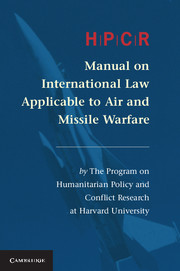Book contents
- Frontmatter
- Contents
- Foreword
- Introduction
- Black-Letter Rules of the HPCR Manual on International Law Applicable to Air and Missile Warfare
- Commentary to the HPCR Manual on International Law Applicable to Air and Missile Warfare
- Appendix I Group of Experts
- Appendix II Sessions of the Group of Experts
- Appendix III List of Informal Meetings with State Representatives
- Appendix IV Drafting Committee: Members & Meetings
- Appendix V Table of Treaties (Chronological)
- Appendix VI Table of Abbreviations
- Index
Introduction
Published online by Cambridge University Press: 05 July 2013
- Frontmatter
- Contents
- Foreword
- Introduction
- Black-Letter Rules of the HPCR Manual on International Law Applicable to Air and Missile Warfare
- Commentary to the HPCR Manual on International Law Applicable to Air and Missile Warfare
- Appendix I Group of Experts
- Appendix II Sessions of the Group of Experts
- Appendix III List of Informal Meetings with State Representatives
- Appendix IV Drafting Committee: Members & Meetings
- Appendix V Table of Treaties (Chronological)
- Appendix VI Table of Abbreviations
- Index
Summary
The Background of the Project
Following a series of informal consultations with scholars and governmental experts, the Program on Humanitarian Policy and Conflict Research atHarvard University (HPCR) launched in 2004 a multi-annual project, with a view to restating the existing law of air and missile warfare. This initiative, based on the work of renowned international legal experts, culminated in the formulation of the present HPCR Manual on International Law Applicable to Air and Missile Warfare (hereinafter: the HPCR Manual).
Some 80 years earlier, in 1923, the famous Rules of Air Warfare were informally drafted at The Hague by a Commission of Jurists (established in 1922 by theWashington Conference on the Limitation of Armament). The Hague Rules, albeit not binding, have had considerable impact on the development of the customary law of armed conflict. Still, much has happened in the intervening 80 years in air warfare, which was in its infancy when the Hague Rules were drawn up. Air power has become a central component of the military arsenal of States and plays a critical role in modern warfare. As for missiles, they were not even conceived in 1923. The exponential changes brought about in air and missile technology in the last few decades have transformed the face of the modern battlefield, revolutionized military strategy, and created a series of distinct challenges to the protection of civilians in time of armed conflict.
- Type
- Chapter
- Information
- Publisher: Cambridge University PressPrint publication year: 2013

